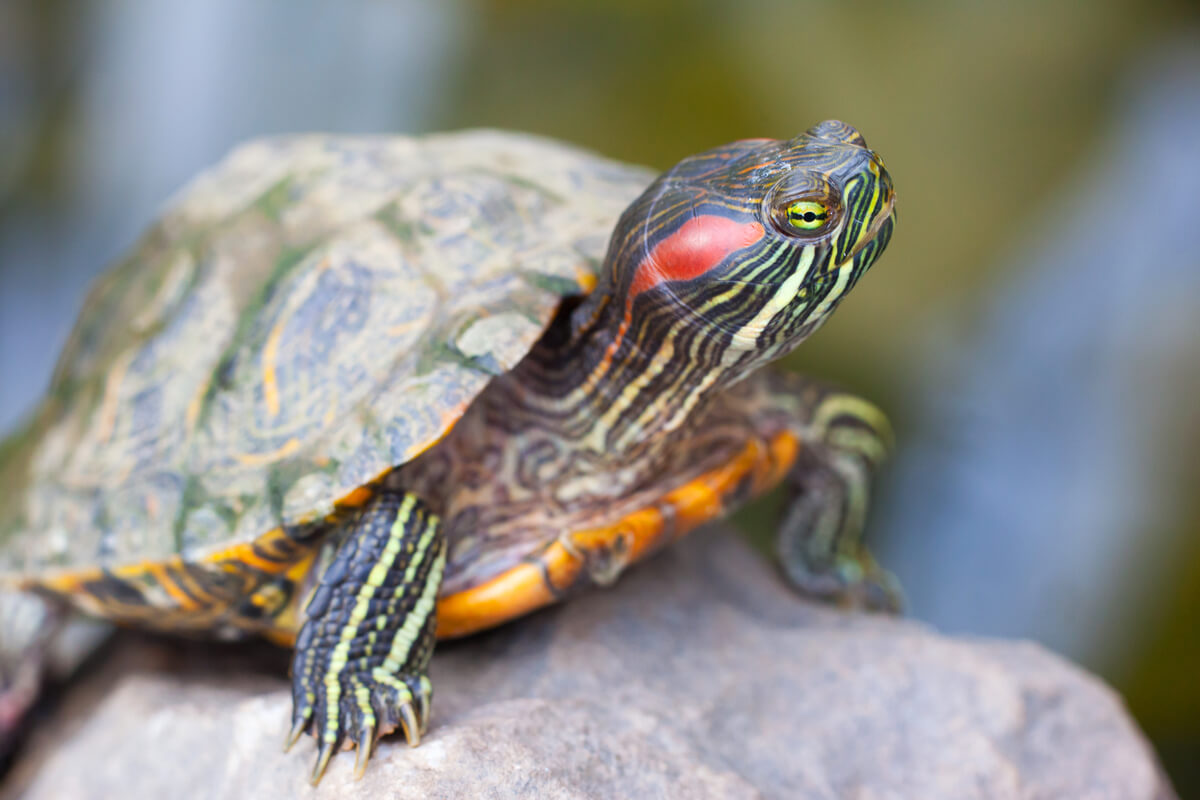How Long Does a Pet Turtle Live?

Responsible pet ownership is becoming more and more popular, especially when it comes to exotic animals. It’s no wonder, because sometimes the commitment can last a lifetime. Knowing how many years a pet turtle lives is essential before you decide to take it home, as some species can be incredibly long-lived.
Are you curious to know how long one of these chelonians is able to live? Here’s the answer, and if you want a companion for life, you may find it in the form of a turtle.
Turtle characteristics
Turtles or chelonians belong to the order of Testudines reptiles, characterized by having their backbone welded to a shell that serves as protection against attacks by predators. They’re the oldest reptiles on Earth and the most ancient fossils of this taxon date from the Triassic period, which took place 220-210 million years ago.
There are currently 250 recognized species of turtles, distributed in 2 suborders (Cryptodira and Pleurodira), classified in 15 families.
The specific characteristics of each species depend on the environment they live in. Classified by their adaptations to their habitat, turtles can be divided into 3 categories:
- Land tortoises: Most of the land tortoises belong to the family Testudinidae, which groups 42 species. They’re characterized by their thick, strong limbs and their spherical, raised shells. Most of them are herbivorous and perform seed dispersal functions in their ecosystems.
- Sea turtles: Belonging to the superfamily Chelonioidea, sea turtles are characterized by being perfectly adapted to life in the sea, as they only come ashore to lay their eggs. There are currently 7 known species of sea turtles, all belonging to the Cheloniidae or Dermochelydae families.
- Freshwater turtles: The adaptation of their limbs allows them to combine swimming with land travel. These turtles spend most of their time in the water, but frequently go ashore to sunbathe, reproduce, or feed.
The incredible biological variety of chelonians makes answering the question of how long a turtle lives a difficult task. Below is an approximation, depending on the species.

How long does a pet turtle live?
The life expectancy range of a pet turtle varies depending on the species and, above all, on the care given to it. To give you an idea, a chelonian without specialized care usually lives 10 years or less, but, if kept in optimal conditions, it can reach 80 years.
No wonder turtles populate legends about the creation of the world: imagine several generations of humans succeeding one another while a single turtle outlives them all.
Larger species tend to live longer than smaller ones. For example, the giant tortoise of the Galapagos can live more than a century and a half. The record was held by Harriet, who died at the age of 175 in a zoo in Queensland, Australia.
The life expectancy of the most common domestic tortoises
If you’re considering getting a turtle, the age it can reach is an important factor in your decision. Will you be able to care for it for the rest of its life? It may even outlive you if you adopt it at a certain age, so you have to ask yourself what will happen to your turtle when you’re gone.
These chelonians usually live more than 10, 2o, 3o, or 4o years when kept in a good condition. Here’s the life expectancy of the most common tortoises that can be found in homes:
- The red-eared slider (Trachemys scripta elegans): Years ago, this chelonian became fashionable in pet shops, but the difficulty of its care caused a wave of abandonment with its consequent introduction into ecosystems that didn’t correspond to it. In Spain, for example, its possession, transport, traffic, and trade are forbidden. It can live more than 40 years.
- Eastern Box Turtle (Terrapene carolina carolina): This land turtle is native to the eastern United States. Although in the wild they live up to 80 years, in captivity they never live more than 50 years.
- Painted turtle (Chrysemys picta bellii): Characterized by its bright red plastron, the possession and trade of this freshwater reptile is also prohibited, as it’s considered an invasive species. In captivity, it reaches 30 years of life without a problem.
- Northern map turtle (Graptemys geographica): It gets its name from the spots on its carapace, which are similar to the drawing of a map. Its life expectancy varies greatly depending on the quality of its care, ranging from 15 to 100 years.
- Forest turtle (Glyptemys [Clemmys] insculpta): This is an endangered species due to the destruction of its habitat and the capture of specimens for pets. In captivity, it lives for almost 60 years.

Turtles are a long-term responsibility
As you can see, although the range of years a pet turtle lives varies, it never falls below a decade. Before acquiring one, consider whether you meet the conditions necessary to give him a good life in the long term. You should also take into account that almost all species grow very large and need plenty of living space.
Of course, ultimately you should find out about the regulations regarding the keeping of the species of interest, as some turtles are protected globally and others are considered invasive in certain regions. Owning a chelonian isn’t a game, so think about it carefully.
Responsible pet ownership is becoming more and more popular, especially when it comes to exotic animals. It’s no wonder, because sometimes the commitment can last a lifetime. Knowing how many years a pet turtle lives is essential before you decide to take it home, as some species can be incredibly long-lived.
Are you curious to know how long one of these chelonians is able to live? Here’s the answer, and if you want a companion for life, you may find it in the form of a turtle.
Turtle characteristics
Turtles or chelonians belong to the order of Testudines reptiles, characterized by having their backbone welded to a shell that serves as protection against attacks by predators. They’re the oldest reptiles on Earth and the most ancient fossils of this taxon date from the Triassic period, which took place 220-210 million years ago.
There are currently 250 recognized species of turtles, distributed in 2 suborders (Cryptodira and Pleurodira), classified in 15 families.
The specific characteristics of each species depend on the environment they live in. Classified by their adaptations to their habitat, turtles can be divided into 3 categories:
- Land tortoises: Most of the land tortoises belong to the family Testudinidae, which groups 42 species. They’re characterized by their thick, strong limbs and their spherical, raised shells. Most of them are herbivorous and perform seed dispersal functions in their ecosystems.
- Sea turtles: Belonging to the superfamily Chelonioidea, sea turtles are characterized by being perfectly adapted to life in the sea, as they only come ashore to lay their eggs. There are currently 7 known species of sea turtles, all belonging to the Cheloniidae or Dermochelydae families.
- Freshwater turtles: The adaptation of their limbs allows them to combine swimming with land travel. These turtles spend most of their time in the water, but frequently go ashore to sunbathe, reproduce, or feed.
The incredible biological variety of chelonians makes answering the question of how long a turtle lives a difficult task. Below is an approximation, depending on the species.

How long does a pet turtle live?
The life expectancy range of a pet turtle varies depending on the species and, above all, on the care given to it. To give you an idea, a chelonian without specialized care usually lives 10 years or less, but, if kept in optimal conditions, it can reach 80 years.
No wonder turtles populate legends about the creation of the world: imagine several generations of humans succeeding one another while a single turtle outlives them all.
Larger species tend to live longer than smaller ones. For example, the giant tortoise of the Galapagos can live more than a century and a half. The record was held by Harriet, who died at the age of 175 in a zoo in Queensland, Australia.
The life expectancy of the most common domestic tortoises
If you’re considering getting a turtle, the age it can reach is an important factor in your decision. Will you be able to care for it for the rest of its life? It may even outlive you if you adopt it at a certain age, so you have to ask yourself what will happen to your turtle when you’re gone.
These chelonians usually live more than 10, 2o, 3o, or 4o years when kept in a good condition. Here’s the life expectancy of the most common tortoises that can be found in homes:
- The red-eared slider (Trachemys scripta elegans): Years ago, this chelonian became fashionable in pet shops, but the difficulty of its care caused a wave of abandonment with its consequent introduction into ecosystems that didn’t correspond to it. In Spain, for example, its possession, transport, traffic, and trade are forbidden. It can live more than 40 years.
- Eastern Box Turtle (Terrapene carolina carolina): This land turtle is native to the eastern United States. Although in the wild they live up to 80 years, in captivity they never live more than 50 years.
- Painted turtle (Chrysemys picta bellii): Characterized by its bright red plastron, the possession and trade of this freshwater reptile is also prohibited, as it’s considered an invasive species. In captivity, it reaches 30 years of life without a problem.
- Northern map turtle (Graptemys geographica): It gets its name from the spots on its carapace, which are similar to the drawing of a map. Its life expectancy varies greatly depending on the quality of its care, ranging from 15 to 100 years.
- Forest turtle (Glyptemys [Clemmys] insculpta): This is an endangered species due to the destruction of its habitat and the capture of specimens for pets. In captivity, it lives for almost 60 years.

Turtles are a long-term responsibility
As you can see, although the range of years a pet turtle lives varies, it never falls below a decade. Before acquiring one, consider whether you meet the conditions necessary to give him a good life in the long term. You should also take into account that almost all species grow very large and need plenty of living space.
Of course, ultimately you should find out about the regulations regarding the keeping of the species of interest, as some turtles are protected globally and others are considered invasive in certain regions. Owning a chelonian isn’t a game, so think about it carefully.
All cited sources were thoroughly reviewed by our team to ensure their quality, reliability, currency, and validity. The bibliography of this article was considered reliable and of academic or scientific accuracy.
- Blake, S., Wikelski, M., Cabrera, F., Guezou, A., Silva, M., Sadeghayobi, E., … & Jaramillo, P. (2012). Seed dispersal by Galápagos tortoises. Journal of Biogeography, 39(11), 1961-1972.
- Chrysemys picta (Painted Turtle). (s. f.). Animal Diversity Web. Recuperado 11 de octubre de 2021, de https://animaldiversity.org/accounts/Chrysemys_picta/
This text is provided for informational purposes only and does not replace consultation with a professional. If in doubt, consult your specialist.








